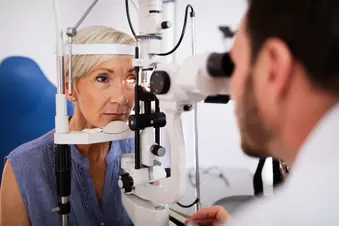
Thyroid eye disease can be tricky to diagnose. Though the condition is related to a thyroid problem called Graves’ disease, the symptoms of each don't always show up at the same time. Also, issues like eye redness and pain can be hard to tell apart from other eye problems. But thyroid eye disease can be very uncomfortable, and sometimes it can affect your vision. It’s important to get the right diagnosis.
Routine Eye Exams
Some people already know they have the related thyroid condition, Graves' disease. They aren't surprised when they get their first eye symptoms. Eye problems often appear within 6 months of a Graves' disease diagnosis.
Once you know you have Graves’ disease, it's important to keep up with your eye doctor visits. It might be in a routine visit with your eye doctor that the path towards a diagnosis of thyroid eye disease begins.
Your eye doctor will do regular exams. During these checkups, they will ask whether you've had any vision problems and will look for symptoms such as:
- Swelling in and around your eyes
- Eyelid openings that are wider than normal
- Bulging eyes
- Misaligned eyes that don’t seem to focus on the same object at once
Your eye doctor will also check your vision. This may include tests of your color vision, as well as your central and side (peripheral) vision. The doctor will also measure your eyelids. Thyroid eye disease can make them swell or pull back.
In some cases, eye symptoms show up a few months before Graves' disease symptoms. If you didn't know you had a thyroid disorder, the sudden appearance of puffy eyelids, double vision, a gritty feeling in your eyes, or light sensitivity might send you to your eye doctor in search of answers.
Which Doctors Diagnose Thyroid Eye Disease?
A thyroid eye disease diagnosis often involves a joint effort between an eye doctor, a primary care doctor, and an endocrinologist -- a specialist who treats thyroid disease. The eye doctor will ask whether you've ever had thyroid problems or have an autoimmune disease. Your endocrinologist might ask if you have any eye symptoms.
Your endocrinologist or primary care doctor can do blood tests to check your thyroid hormone levels and confirm the diagnosis. Graves' disease causes higher-than-normal thyroid hormone levels, but it is possible to have normal thyroid hormone levels and still have eye problems.
Tests
You may need one or more of these imaging tests to see whether you have swelling inside your eye or enlarged eye muscles:
- Ultrasound uses high-frequency sound waves to take pictures of the structures around your eyes.
- Computed tomography (CT) scans take X-ray pictures of your eyes from many different angles to make very detailed pictures.
- Magnetic resonance imaging (MRI) uses magnets and radio waves to take pictures of your eyes.
Your doctor might also check your eye pressure. Thyroid eye disease can cause the pressure inside the eye to rise, which puts you at risk for glaucoma. The doctor will also check the health of your optic nerve, which sends information from your eyes to your brain.
If you do confirm that you have thyroid eye disease, your doctor will work with you to choose the best medical treatments and at-home remedies to relieve your symptoms.